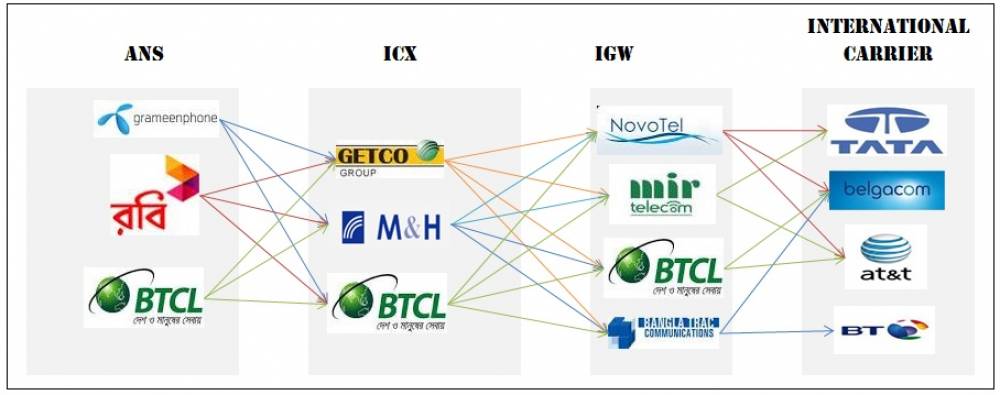Framework for International Long Distance Telecommunications Service (ILDTS)
The current policy 2020 framework is constructed in three layers: 1. International layer. All international voice calls, including VoIP calls originating from Bangladesh, are routed through international gateways (IGWs). In a similar manner, all data traffic is routed through International Internet Gateways (IIGs) except for data that is handled by international private leased circuit (IPLC). The IGWs and IIGs operate primarily over International Long Distance Cable (IDLC), but with satellite back-up facilities. IGWs are primarily located in Dhaka, but IIGs have to operate points of presence (POPs) in at least two locations, as allocated by BTRC, so that POPs exist in at least 11 specified cities.
2. National layer. All national inter-operator voice calls, including VoIP calls, are routed through Interconnection Exchanges (ICXs). In the same manner, all national inter-operator data traffic is to be routed through National Internet Exchanges (NIXs). Each ICX / NIX has to operate points of presence (POPs) in at least two locations, as allocated by BTRC, so that POPs exist in at least 11 specified cities.
3. Access layer. Access Network Services (ANS) operators provide services to end-users. They use either fixed (Public Switched Telephone Network, PSTN) or mobile (Public land Mobile Network, PLMN) technology. They interconnect via the ICX (for voice) and the NIX (for data) traffic. ANS have to interconnect with a minimum of three ICX operators, whether it is efficient to do so or not.
If you really want know the big picture of our Telecom Sector then here is it.
End User»Service Provider»IIG»ITC/BSCCL»Carrier»Cloud
The Physical lines that are connecting the Service Providers and IIG and ITC is been provided by another entity referred as NTTN [Nationwide Telecommunication Transmission Network]. And currently we only have two such players who are kind of playing monopoly in the market. They are:
- Summit Communications Limited
- Fiber @ Home Limited and
Combination- ANS, ICX and IGWs.
Who are these ANSs? As you can guess from the picture, the Mobile or Land Phone Operators are referred as ANS [Access Network Service]. Grameen Phone, Bangla Link, Robi or CityCell they all are ANS.
Who are the ICXs? If a Subscriber calls from GP to GP then the call get route internally. But if a Subscriber calls from GP to BanglaLink then the call gets routed via ICX. Yap, they are the middleman sitting right in the middle enjoying the cream. ICX Stands for Inter Exchange.
Who are the IGWs? The word IGW stands for International Gateway. Both the term International and Gateway here is important. If you are calling abroad or receiving the call from outside the country, then the calls has to enter through the IGWS. The iGW operators then route the calls towards ICX and the ICX then routes them to the intended ANS Operator.
Who are the International Carriers? The international Carriers or simply saying carriers are the WholeSale Telecom Operator who are connected directly or indirectly to different countries. From any part of the world if any of your relatives gives you a call, then the call are being carried by these Carriers to the IGWs. They are the key players that makes the difference for IGWs. If an IGW has more connection with more bigger Carriers, then chances are higher that they will receive more calls and thus can make more money out of it.
In the Telecom Industry, there is a saying, “If A Party is Using B Party’s Network then B Party will Charge for that”. The charges could be on Pulse based or just One Second incremental based, it varies. The fancy term used to identify this phenomenon is known as Revenue Sharing


